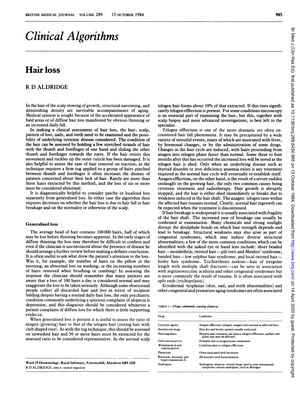Hair Loss
October 1984
in “
The BMJ
”
hair loss patchy hair loss generalized hair loss tug test anagen to telogen hair ratio telogen effluvium stress hormonal changes drugs congenital syndromes thyroid disorders iron deficiency anemia alopecia alopecia areata traction alopecia trichotillomania drug-induced hair loss androgenic alopecia cicatricial alopecias follicular damage allergic contact dermatitis eczema hair thinning stress-related hair loss hormonal hair loss drug-related hair loss genetic hair loss permanent hair loss scarring alopecia

TLDR Up to 50% of scalp hair can be lost before it appears thin, and treatment is only needed for hair loss caused by diseases or deficiencies.
In 1984, a document detailed the clinical assessment of hair loss, distinguishing between patchy and generalized loss, and noting that up to 50% of scalp hair can be lost before thinning is visible. It described diagnostic techniques like the tug test and the anagen to telogen hair ratio, with a rise in telogen hairs indicating telogen effluvium. The document identified stress, hormonal changes, drugs, and congenital syndromes as causes of hair loss, stating that treatment is necessary only when associated with diseases like thyroid disorders or iron deficiency anemia. It listed drugs that commonly cause alopecia and provided an algorithm for diagnosis. Treatment options for alopecia areata, traction alopecia, trichotillomania, and drug-induced loss were discussed. The document also focused on androgenic alopecia, prevalent in men and some women, often with a genetic component, and characterized by hair thinning. It mentioned cicatricial alopecias, which lead to permanent loss due to follicular damage, and the potential rubber allergy causing allergic contact dermatitis in eczema patients.





